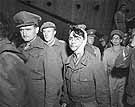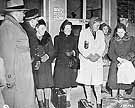
|
|
|

|

|

|

|
|
Click on an image to see a larger, more detailed picture.
|
|
|
|
|
| 1946: The Pursuit of Justice |

|
pg. 653 |

|
|
|
|
| |
 The young man with the bandaged head was a passenger on the ship Knesset Israel, which transported illegal Jewish immigrants to Israel. The British made a concerted effort to stop such unauthorized settlement, and several British warships overtook Knesset Israel. In the course of the boarding of the ship, two young Jewish men were killed by gunfire and 57 were sent to the hospital with injuries. The British sent Knesset Israel's passengers to a detention camp on the island of Cyprus.
The young man with the bandaged head was a passenger on the ship Knesset Israel, which transported illegal Jewish immigrants to Israel. The British made a concerted effort to stop such unauthorized settlement, and several British warships overtook Knesset Israel. In the course of the boarding of the ship, two young Jewish men were killed by gunfire and 57 were sent to the hospital with injuries. The British sent Knesset Israel's passengers to a detention camp on the island of Cyprus.
Photo: Wide World Photo
|
 Nazi physicians had committed horrific crimes against camp inmates, and the Allies were determined to hold them responsible. In 1946-47, 23 doctors stood trial in Nuremberg for crimes against humanity. The four women pictured here, all victims of Nazi medical "experiments," arrived in Nuremberg on December 15, 1946, in order to testify against the accused. The German medical profession struggled to recover from the horrors perpetrated by some of its members.
Nazi physicians had committed horrific crimes against camp inmates, and the Allies were determined to hold them responsible. In 1946-47, 23 doctors stood trial in Nuremberg for crimes against humanity. The four women pictured here, all victims of Nazi medical "experiments," arrived in Nuremberg on December 15, 1946, in order to testify against the accused. The German medical profession struggled to recover from the horrors perpetrated by some of its members.
Photo: National Archives
|
|
The Uniqueness of the Holocaust Genocide involves state-organized destruction of a people because of what political scientist R. J. Rummel calls "their indelible group membership (race, ethnicity, religion, language)." Nazi Germany's destruction of European Jewry was clearly genocide; however, was the Holocaust unique? Arguments for the Holocaust's uniqueness do not depend primarily on the number of Jewish victims or the way in which they were killed. Rather, as scholar Steven T. Katz maintains, the uniqueness claim rests on "the fact that never before has a state set out, as a matter of intentional principle and actualized policy, to annihilate physically every man, woman, and child belonging to a specific people....Only in the case of Jewry under the Third Reich was such all-inclusive, noncompromising, unmitigated murder intended." The uniqueness claim sparks debate. Some scholars contend, for example, that Nazi Germany's targeting of the Sinti and Roma (Gypsies) did not differ substantially from the fate intended for the Jews. Others fear that the uniqueness claim banishes other genocides to undeserved second-class status. Inquiry about these issues will not stop any time soon, but Holocaust scholar Yehuda Bauer, who defends the Holocaust's uniqueness, offers an important reminder: "Events happen because they are possible. If they were possible once, they are possible again. In that sense, the Holocaust is not unique, but a warning for the future."
|
|

|

|

|

|
 October 25, 1946: Twenty-three former Nazi doctors are tried at Nuremberg on charges of conducting unethical experiments on camp inmates. The various experiments included the drinking of seawater, bone grafting, exposure to mustard gas, and other atrocities. This is the so-called "doctors' trial"; See August 20, 1947.
October 25, 1946: Twenty-three former Nazi doctors are tried at Nuremberg on charges of conducting unethical experiments on camp inmates. The various experiments included the drinking of seawater, bone grafting, exposure to mustard gas, and other atrocities. This is the so-called "doctors' trial"; See August 20, 1947.
|
 November 13, 1946-April 17, 1947: Former Luftwaffe Field Marshal Erhard Milch is tried at Nuremberg.
November 13, 1946-April 17, 1947: Former Luftwaffe Field Marshal Erhard Milch is tried at Nuremberg.
|
 December 11, 1946: The United Nations General Assembly confirms the judgments of the Nuremberg Tribunal.
December 11, 1946: The United Nations General Assembly confirms the judgments of the Nuremberg Tribunal.
|
 1946-1949: In 12 separate tribunals, an additional 185 alleged Nazi war criminals are prosecuted at Nuremberg.
1946-1949: In 12 separate tribunals, an additional 185 alleged Nazi war criminals are prosecuted at Nuremberg.
|
|
|
|
|
| 1946: The Pursuit of Justice |

|
pg. 653 |

|
|
The Holocaust Chronicle
© 2009 Publications International, Ltd.
|
|
